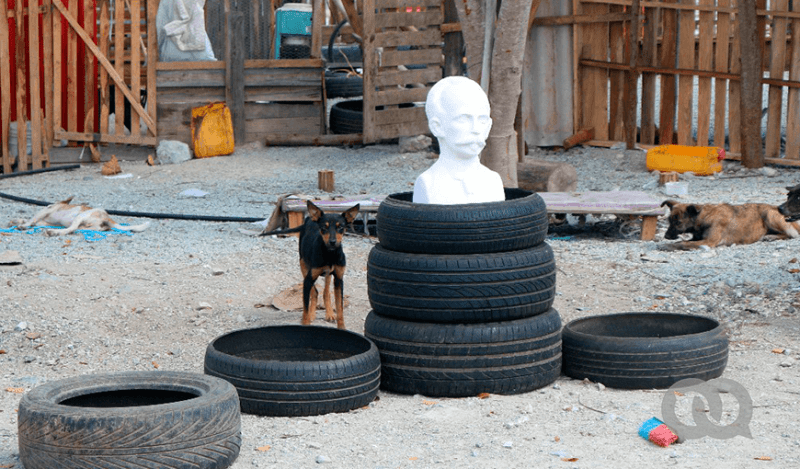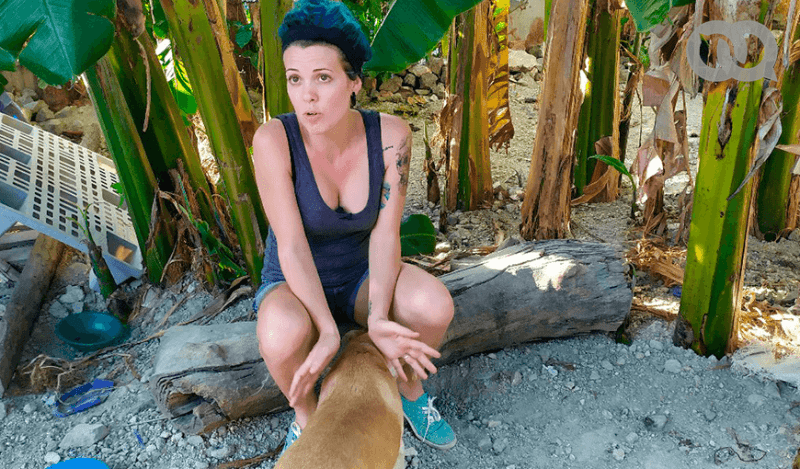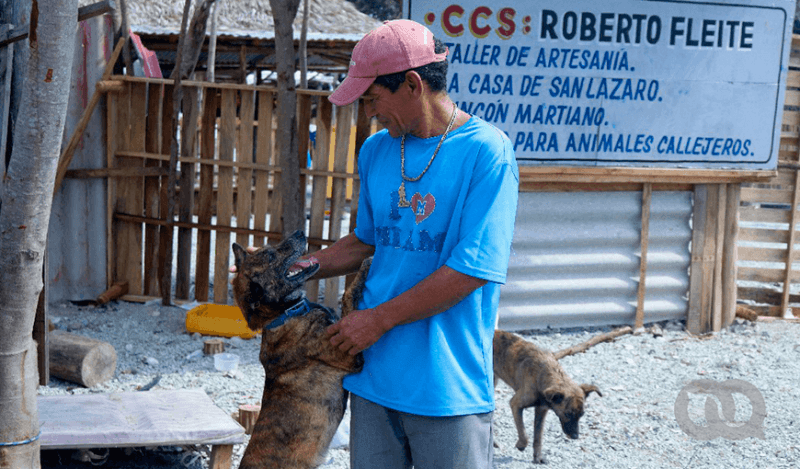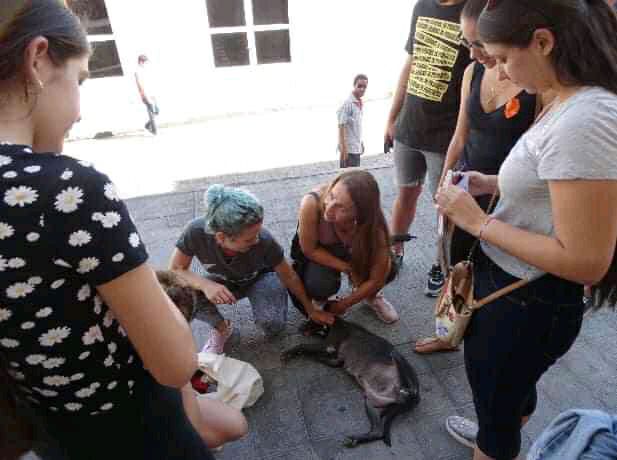Animal Protection in Santa Clara, Cuba: Popular Tradition Driven by a Donkey
By Glenda Boza Ibarra (El Toque)

HAVANA TIMES – A donkey wanders through the city. He knocks on doors with one of his front hooves. He wants bread. Neighbors don’t turn their backs on him: they stroke him, protect him, feed him. He only has one owner, but many who care. He roams the streets alone. Nobody is afraid of him, nobody beats him, nobody takes him. His name is Perico and it’s the 1930s and ‘40s in Santa Clara.
Gustavo Mena Artola knows this story off by heart. He remembers it sometimes, while “diving” in the trash. He finds rusty tanks without a bottom, old car tires, jugs and pots. He doesn’t care that people call him a “diver” because he rummages about in the garbage, or that people think he is mad. Gustavo is only mad about his dogs, the 40 dogs he looks after at one of the animal shelters in Santa Clara.

Gustavo doesn’t have a license or permit. Nor is there a ban that prohibits him from keeping animals on his property. Neighbors don’t complain. The contrary in fact, they help in any way they can: with food, cleaning, medicine.
“My grandson brings his friends and they help me out with many things around the shelter: cleaning, feeding the animals, looking after them,” he says.
Even though Gustavo has had many animals in his home for years now, the San Lazaro Vigio shelter has only existed since 2018. There are only two shelters like this one in Santa Clara, which house almost a hundred animals. However, this isn’t enough.
Perico is the starting point
People say that Perico the donkey marched with students in their protests. That he even carried placards on his back against the government at the time or any another authority. Maybe it was because of his ground-breaking story that Perico’s statue was chosen as the final destination when the idea of an animal welfare march in Santa Clara was conceived. But that was a failed attempt that Javier Larrea would prefer not to remember or speak about.
However, Larrea is still leading the struggle here for an Animal Protection Act and other initiatives that protect stray dogs and cats, or any animal; and contribute to raising awareness and a culture of respect towards them.
“When I was doing my military service, many friends and I would go to the zoo to help out with the animals,” he tells us.
Javier recalls his childhood in Caibarien with his grandfather, when he first began rescuing animals. Right now, he is focusing all of his efforts on the Cuban Animal Welfare project, a network of integrated collaborative efforts by animal rights advocates mostly in Havana, Camaguey, Matanzas, Santa Clara and Sancti Spiritus.
“Many people believe that the objective is just to put these animals into a shelter, but that is only a short-term solution,” Javier explains. “This network will allow people who can’t have an animal at home but would like one, to contribute with food, donations, having at animal at home a few days (“transition houses”) etc.”
Using social media mostly to mobilize people, Javier says that many people have become involved and have even rescued animals.
“People who never used to do anything, or didn’t know what to do or how, are now making the most of this network to join the movement in each of their areas,” Javier says.
Animal rights advocates: As real as Perico
Maykel Iglesias, the Santa Clara choir director, published a post on his Facebook profile saying that Perico’s story should be the city’s main motivation for advocating No to Animal Abuse. “Let’s not forget that we have inherited a donkey who used to wander our streets and who this city loved dearly; let’s not forget that the city shut down the day he died because they loved him,” the musician wrote.
“Perico is a symbol of animal protection, in my eyes,” Maykel says while dreaming that the animal rights movement can achieve a lot more.
Leydi Laura Hernandez is also an activist and advocates for promoting the movement in Santa Clara. Even though it isn’t known just how people are in favor of an Animal Protection Law, there are apparently quite a few judging by comments and posts on social media. Mostly on Facebook.

“When we need something, we post on this social network,” she says. “Sometimes, somebody offers this help and new people appear who join the movement, although we’re always the same people “on the ground”.”
Lizandra Martin, an actress in Mejunje theater group and activist, says that she learned about what was happening in Santa Clara through a post.
“I study in Havana, but when I saw what people were doing there I immediately wanted to join,” she says. “I told Leydi that I don’t just talk for the sake of it, and that I was going to stick my elbows in so deep that she was going to get tired of me, and that’s what happened – not the part of getting tired of me, of course…,” she jokes.
Activists say that they have tried to mix politics with animal rights a lot of times, but that this only detracts from the true essence of this struggle. Plus, they can see that many people look at them and their movements suspiciously, from afar, and that closes doors for them a lot of the time.
“Luckily, there is always someone who wants to help and the support from actress Roxana Pineda (who is well-known locally and nationally), for example, has been crucial,” Lizandra says.
“Artists are very important as opinion makers for causes such as this one,” Lizandra admits. “Not only because they have the ability to mobilize people, but because they also have the stubbornness to say yes we can, when we are told no we can’t.”
In addition to the pages that already exist for animal wellbeing and protection in Cuba, we created a Facebook group to directly engage people in the city.
“We called it Por Una Voz Animal Santa y Clara and we publish information about animal rescues, missing pets, possible adoptions, vaccination, de-worming and sterilization campaigns there, and any other information we find to be relevant.”
Leydi, Javier, Lizandra and Gustavo agree on the fact that social media has been a driving force in the animal protection struggle. Not only to give visibility to what is being done in every region or to mobilize people for concrete events, but also to bring people together and to send messages to them.
“On December 17th, we held an activity for children and also a dog adoption at the Mejunje bar and over 100 people came,” Leydi says. “People found out about it mostly via social media. Some people went with their pets and others adopted right there on the spot, while others were left wanting to take an animal home. On February 29th, we’ll hold another activity like this one.”
Gustavo publishes photos of rescued animals, children and adults helping him at his shelter, and even of his “dives” in garbage looking for anything that might improve the condition of his animals, on his own Facebook page.
He admits that he doesn’t always have the best penmanship and spelling – “the thing is I’m a yam and I don’t have autocorrect on my phone,” he says, but it is thanks to these posts that people come and help and he can dedicate his time to the shelter.

“It’s almost 15 pounds of rice and 20 kilos of some form of protein just in food every day,” he says. “Plus ever since there have been food shortages, people have stopped adopting because they don’t think they can afford to feed “another mouth”. But pets stop becoming a burden with a lot of dedication.”
The friendly ghost of Perico the donkey
Perico the donkey was the people of Santa Clara’s pet. The donkey had their affection, admiration and care. People say that he would often wander around Vidal park and that everybody would look at him with great tenderness, stroke him or pamper him. However, dogs hanging around the park haven’t been so lucky. Most people ignore them. Some even abuse them.
“That’s why we decided to tag them,” Leydi Laura says. “We put a collar on them with a card and their name, one of our phone numbers and info about their sterilization and de-worming on it.”
People call them “community dogs” and now when they wander between the boulevard and Vidal park, people feed them more, look after them and even call the contact number that appears on the card if anything happens to them.

“There are people who passed by the dog a thousand times, but they just saw it as a stray,” Leydi laments. “However, when they see this information hanging from their neck, they feel like it has an owner and they don’t look at it or treat it in the same way.”
The initiative, which was taken from a similar one adopted by the Havana Historian’s Office, allowed them to “tag” six dogs. Nevertheless, this doesn’t stop them from being taken away by Zoonosis (the dog catcher).
“A while ago, I received a call to tell me that Negrita had been taken by a Zoonosis truck,” Leydi says.
The dog had just given birth in the boulevard area and she was picked up. Leydi rescued her along with her puppies and took them to her shelter. She now has 48 dogs.
“This is why the sterilization campaign is so important, but this is a process that takes time and resources,” Leydi says. “Plus, on top of that, almost nobody wants to adopt an adult dog.”
Gustavo says that it is a myth that an adult dog can’t be trained. “Many people only want pups because they believe adult dogs give more problems, but they are better in lots of ways,” he recognizes. “Here, I receive dogs of all ages and they have all adapted to my timetable and discipline.”
Leydi and Gustavo know better than anyone else the financial and personal sacrifice involved in having a dog shelter. Even though volunteers help them, and some people donate clothes, food, medicine, the shelter should only be a temporary situation, but it will be some dogs’ home for the rest of their lives.
“Some dogs have “sponsors”, people who can’t keep them at home, but come on the weekend, take them out for a walk, bring them food, play with them, etc.,” Lizandra says. “The ideal thing would be for them to end up adopting them, but we understand that people aren’t always in a situation where they can.”
Leydi explains that there are also institutions, businesses and workplaces that have “adopted” their own pets and that sometimes they are called to vaccinate, de-worm, sterilize and treat them when they fall sick.
Even though there are vets who also help them, they aren’t always available when they are needed. However, the group of animal rights advocates in Santa Clara has learned to look after them in the best possible way from experience, desire and especially love.

“I have had dogs with scabies who I have treated with baths,” Gustavo says. “An animal only needs food and love to be happy.”
After every rescue, the activists take a picture and upload it to social media. They want a record of just how much they do, even if it still isn’t enough. Just like their own photos, photos of Perico the donkey being fed by neighbors are proof that there is an innate tradition of animal protection in Santa Clara. These animal rights advocates are bringing it back to life.
